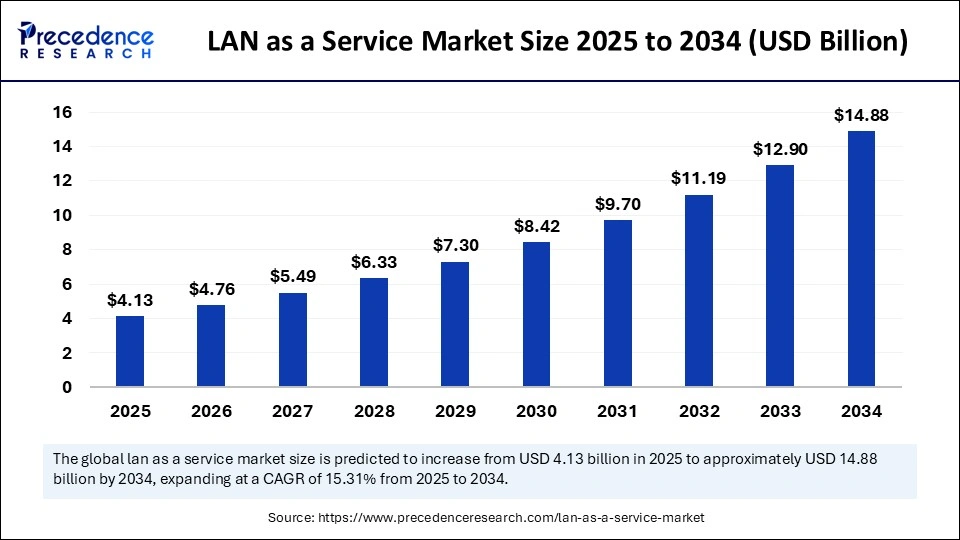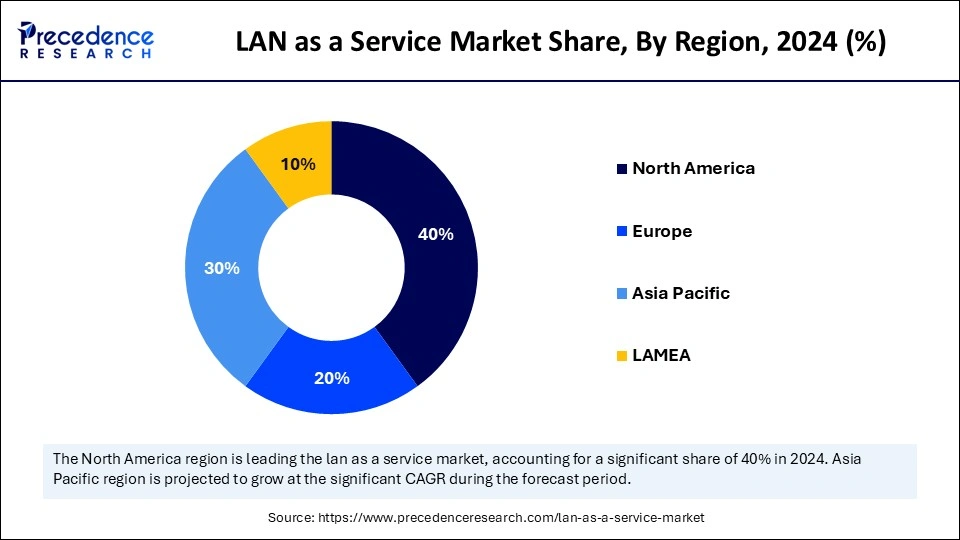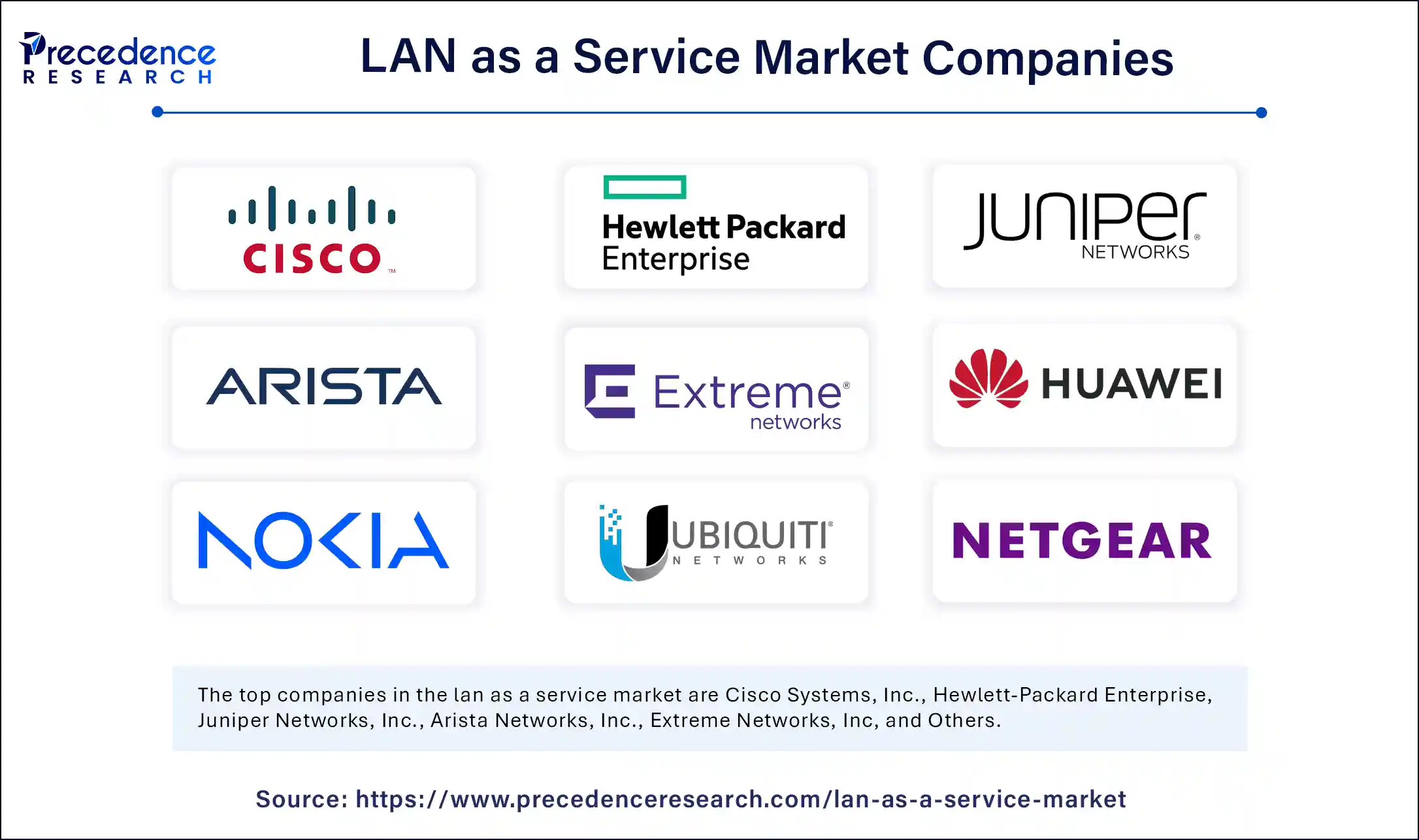The global LAN as a service market size is estimated to worth around USD 14.88 billion by 2034 increasing from USD 3.58 billion in 2024, with a CAGR of 15.31%.

LAN as a Service Market Key Insights
-
North America led the LAN as a Service market in 2024, accounting for the largest revenue share of 40%.
-
Asia Pacific is projected to record the fastest CAGR during the forecast period from 2025 to 2034.
-
By service type, the wired LAN segment held the dominant market share in 2024.
-
The wireless LAN segment is anticipated to experience notable growth from 2025 to 2034.
-
Based on the deployment model, the cloud-based segment was the market leader in 2024.
-
The on-premises segment is expected to grow significantly during the forecast period from 2025 to 2034.
-
By enterprise size, large enterprises dominated the market in 2024.
-
The SMEs segment is predicted to grow at a substantial rate in the upcoming years (2025–2034).
Role of AI in LAN as a Service (LANaaS) Market
Artificial Intelligence (AI) is playing a pivotal role in transforming the LAN as a Service market by enabling smarter, more adaptive, and automated network management. AI-powered tools are increasingly being integrated into LANaaS platforms to perform predictive maintenance, detect anomalies, and optimize bandwidth usage in real time. This automation reduces the need for manual intervention, minimizes downtime, and enhances the overall reliability of network services.
Moreover, AI enhances network security within LANaaS by identifying suspicious activities and responding to threats proactively through machine learning-based intrusion detection systems. With the growing complexity of enterprise networks, AI assists service providers in delivering more personalized and efficient LAN solutions, thereby improving service quality and customer satisfaction. This intelligent automation is a key differentiator for vendors in a highly competitive and service-centric LANaaS market.
Get a Free Sample Copy of the Report@ https://www.precedenceresearch.com/sample/6149
Market Overview: Revolutionizing Enterprise Connectivity
Local Area Network as a Service (LANaaS) is a subscription-based model that provides enterprises with outsourced LAN infrastructure and management, enabling streamlined connectivity, reduced capital expenditure, and scalable solutions. Traditionally, companies built and maintained their own LANs, involving significant upfront costs, IT staffing, and maintenance efforts. LANaaS shifts this burden to service providers, who deliver and manage both wired and wireless LAN infrastructure as a service. As businesses increasingly adopt hybrid and remote work environments, and demand flexible and secure connectivity solutions, LANaaS has emerged as a cost-effective and agile alternative. The global LANaaS market has been experiencing robust growth, fueled by increasing digital transformation across sectors, expansion of cloud computing, and growing dependence on mobile and IoT devices.
Growth Factors: Cloud Adoption and Digital Workspaces Drive Demand
The LANaaS market is growing steadily due to several converging factors. Foremost among them is the acceleration of cloud adoption and virtualization, which necessitates seamless, reliable LAN infrastructure across geographically distributed environments. Organizations are also shifting toward digital-first operations, requiring low-latency and high-bandwidth network solutions. The surge in IoT deployments and connected devices in industries such as healthcare, manufacturing, and logistics is further intensifying the need for scalable and managed LAN services. Additionally, the rise of Software-Defined Networking (SDN) and Network Function Virtualization (NFV) technologies has enabled the decoupling of network hardware from software, making it easier for service providers to offer agile and dynamic LANaaS solutions to meet diverse enterprise needs.
Market Scope
| Report Coverage | Details |
| Market Size by 2034 | USD 14.88 Billion |
| Market Size in 2025 | USD 4.13 Billion |
| Market Size in 2024 | USD 3.58 Billion |
| Market Growth Rate from 2025 to 2034 | CAGR of 15.31% |
| Dominating Region | North America |
| Fastest Growing Region | Asia Pacific |
| Base Year | 2024 |
| Forecast Period | 2025 to 2034 |
| Segments Covered | Service Type, Deployment Model, Organization Size, and Region |
| Regions Covered | North America, Europe, Asia-Pacific, Latin America, and Middle East & Africa |
Market Dynamics
Key Market Drivers: Remote Work and Security Pressures
The proliferation of remote and hybrid work models has significantly increased the pressure on organizations to secure and manage their network infrastructure efficiently, especially across dispersed locations. LANaaS helps address these demands by enabling centralized control, monitoring, and security. Another crucial driver is the high cost of maintaining traditional LANs, which includes hardware investments, upgrades, and skilled personnel. With LANaaS, companies can avoid capital expenditure and shift to a predictable operating expenditure model. Furthermore, as businesses adopt digital transformation initiatives, the demand for integrated and flexible LAN management solutions grows. The increased focus on network security, compliance, and real-time performance monitoring also encourages enterprises to move toward professionally managed LAN services.
Opportunities: AI Integration and Industry-Specific Customization
The LANaaS market presents strong opportunities, particularly in the integration of Artificial Intelligence (AI) and Machine Learning (ML) to enhance network performance, predictive maintenance, and automated issue resolution. AI-driven network analytics are enabling smarter, self-healing LAN environments that reduce downtime and boost efficiency. Additionally, there is growing potential for industry-specific LANaaS solutions—such as those tailored for smart factories, healthcare facilities with stringent data security requirements, or retail environments needing real-time analytics. As small and medium-sized enterprises (SMEs) seek enterprise-grade networking capabilities without large IT investments, LANaaS providers have a vast untapped market to penetrate. The increasing adoption of Wi-Fi 6 and 5G technologies also opens new avenues for advanced wireless LAN services.
Challenges: Data Privacy, Vendor Lock-In, and Infrastructure Dependency
Despite its advantages, the LANaaS market faces several challenges. One of the primary concerns is data privacy and security, as outsourcing LAN management to third-party providers can create vulnerabilities if not handled properly. Enterprises, especially those in regulated industries, must ensure that LANaaS providers comply with local data protection laws and industry standards. Another significant challenge is vendor lock-in; once a company commits to a particular LANaaS provider, switching can be difficult and costly. Additionally, organizations operating in regions with poor broadband infrastructure may struggle to fully benefit from LANaaS offerings. There is also resistance from some IT departments concerned about losing control over core network functions.
Regional Outlook: North America Leads, Asia-Pacific Rises
North America held the largest share of the LANaaS market in 2024, driven by early technology adoption, robust IT infrastructure, and the widespread presence of managed service providers. The U.S. and Canada are seeing high demand from sectors like finance, healthcare, and education, which require secure and agile networking solutions. Europe follows closely, particularly in countries like Germany, the UK, and France, where cloud-first initiatives and digital transformation agendas are pushing the adoption of LANaaS.

However, the Asia-Pacific (APAC) region is expected to witness the fastest growth through 2034. The expansion of IT services, growth of data centers, increasing investments in smart cities, and rising cloud adoption in countries like India, China, Japan, and Southeast Asia are creating a fertile ground for LANaaS providers. Latin America and the Middle East & Africa are also gradually adopting LANaaS, particularly in urban centers, although slower infrastructure development and lower cloud maturity may restrain rapid expansion in some areas.
Key Players Operating in the Market

- Cisco Systems, Inc.
- Hewlett-Packard Enterprise
- Juniper Networks, Inc.
- Arista Networks, Inc.
- Extreme Networks, Inc.
- Huawei Technologies Co., Ltd.
- Nokia Corporation
- Ubiquiti Inc.
- Netgear, Inc.
- TP-Link Technologies Co., Ltd.
Segments Covered in the Report
By Service Type
- Wired LAN
- Wireless LAN
By Deployment Model
- Cloud-based
- On-premises
By Organization Size
- SMES
- Large Enterprises
By Region
- North America
- Europe
- Asia Pacific
- Latin America
- Middle East and Africa
Read More: Hadoop-as-a-Service Market
Source: https://www.precedenceresearch.com/lan-as-a-service-market